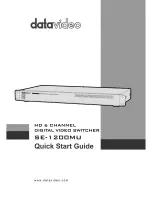
CLI Basics |
19
From this mode, you can enter INTERFACE mode using the
interface
command.
INTERFACE Mode
Use INTERFACE mode to configure interfaces or IP services on those interfaces. An interface can be
physical (for example, a TenGigabit Ethernet port) or virtual (for example, the Null interface).
To enter INTERFACE mode:
1.
Verify that you are logged into CONFIGURATION mode.
2.
Enter the
interface
command followed by an interface type and interface number that is available
on the switch.
3.
The prompt changes to include the designated interface and slot/port number (
Table 3-3
).
LINE Mode
Use LINE mode to configure console or virtual terminal parameters.
To enter LINE mode:
1.
Verify that you are logged in to CONFIGURATION mode.
2.
Enter the
line
command. You must include the keywords
console
or
vty
and their line number
available on the switch.The prompt changes to include (config-line-console) or (config-line-vty).
You can exit this mode using the
exit
command.
MONITOR SESSION Mode
While in CONFIGURATION mode, use the
monitor session
command to enter MONITOR SESSION
mode. Use this mode to configure port monitoring.
To enter MONITOR SESSION mode:
1.
Verify that you are logged in to CONFIGURATION mode.
2.
Use the
monitor session
command. You must enter the monitor session id. The prompt changes to
include (conf-mon-sess).
You can return to CONFIGURATION mode using the
exit
command.
Table 3-3. Interface prompts
Prompt
Interface Type
FTOS(conf-if-te-0/0)#
Ten Gigabit Ethernet interface followed by slot/port information
FTOS(conf-if-vl-1)#
VLAN Interface followed by VLAN number (range 1 to 4094)
FTOS(conf-if-ma-0/0)#
Management Ethernet interface followed by slot/port information
FTOS(conf-if-range)#
Designated interface range (used for bulk configuration; refer to
group
).
Summary of Contents for PowerEdge M IO Aggregator
Page 14: ...12 Before You Start w w w d e l l c o m s u p p o r t d e l l c o m ...
Page 40: ...38 File Management w w w d e l l c o m s u p p o r t d e l l c o m ...
Page 80: ...78 Control and Monitoring w w w d e l l c o m s u p p o r t d e l l c o m ...
Page 90: ...88 u Boot w w w d e l l c o m s u p p o r t d e l l c o m ...
Page 108: ...106 Data Center Bridging w w w d e l l c o m s u p p o r t d e l l c o m ...
Page 114: ...112 Dynamic Host Configuration Protocol DHCP w w w d e l l c o m s u p p o r t d e l l c o m ...
Page 128: ...126 Internet Group Management Protocol IGMP w w w d e l l c o m s u p p o r t d e l l c o m ...
Page 162: ...160 Interfaces w w w d e l l c o m s u p p o r t d e l l c o m ...
Page 178: ...176 IPv4 Routing w w w d e l l c o m s u p p o r t d e l l c o m ...
Page 182: ...180 iSCSI Optimization w w w d e l l c o m s u p p o r t d e l l c o m ...
Page 186: ...184 Link Aggregation Control Protocol LACP w w w d e l l c o m s u p p o r t d e l l c o m ...
Page 190: ...188 Layer 2 w w w d e l l c o m s u p p o r t d e l l c o m ...
Page 210: ...208 Security w w w d e l l c o m s u p p o r t d e l l c o m ...
Page 246: ...244 Uplink Failure Detection UFD w w w d e l l c o m s u p p o r t d e l l c o m ...
Page 262: ...260 Debugging and Diagnostics w w w d e l l c o m s u p p o r t d e l l c o m ...
















































